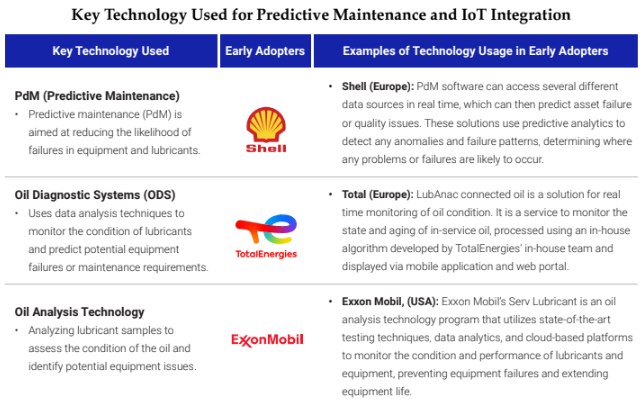

The Southeast Asia (SEA) automotive lubricants market is rapidly evolving with the integration of Internet of Things (IoT) technology. This transformation offers significant benefits, creates new opportunities in smart technology, and introduces innovative IoT solutions that can revolutionize the industry.
One of the primary benefits of IoT integration in the SEA automotive lubricants market is enhanced operational efficiency. Real-time tracking of inventory and shipments allows companies to optimize their supply chains, leading to reduced lead times, lower inventory costs, and improved demand forecasting. Predictive maintenance, enabled by IoT devices, monitors the condition of machinery and vehicles, predicting when maintenance is needed before failures occur. This reduces downtime and extends the lifespan of both the equipment and the lubricants used.
SEA automotive lubricants industry players can apply smart technologies to enhance IoT integration. By leveraging advanced data analytics, AI-driven predictive maintenance, and interconnected sensor networks, companies can significantly improve the efficiency and reliability of their operations. The strategic adoption of innovative technology thus positions the SEA automotive lubricants industry for sustained growth and innovation in a competitive global market.
Predictive maintenance (PdM) aims to reduce the likelihood of equipment and lubricant failures by predicting potential issues before they occur. This approach relies on real-time data and advanced analytics to identify anomalies and failure patterns, allowing for proactive maintenance actions. Shell is one of the players that employs PdM software that accesses various data sources in real-time to predict asset failures or quality issues. By anticipating maintenance needs, SEA automotive lubricant players can avoid unplanned downtimes, reduce maintenance costs, and extend the lifespan of both equipment and lubricants.

Image Source: YCP White Paper
Another smart technology application is oil diagnostic systems (ODS). ODS uses data analysis techniques to monitor the condition of lubricants and predict potential equipment failures or maintenance requirements. These systems provide real-time insights into the state and aging of in-service oil, helping to ensure optimal equipment performance. European player Total’s LubAnac applied this technology to connect oil solution monitors the condition of oil in real-time. The system uses an in-house developed algorithm to process data and displays the results via a mobile application and web portal.
For the SEA automotive lubricants industry, implementing ODS can enhance the ability to monitor lubricant health and predict when oil changes or maintenance are necessary. This real-time monitoring helps maintain optimal equipment performance and prevent unexpected failures that could disrupt operations.
Lastly, oil analysis technology can be the IoT solution for the SEA automotive lubricant industry. Oil analysis technology involves analyzing lubricant samples to assess their condition and identify potential equipment issues. This technology helps monitor the performance of lubricants and the health of machinery, providing insights that can prevent equipment failures and extend equipment life. For instance, Exxon Mobil’s Serv Lubricant oil analysis program uses state-of-the-art testing techniques, data analytics, and cloud-based platforms to monitor the condition and performance of lubricants and equipment. This program helps prevent equipment failures and extend equipment life by providing detailed insights into lubricant conditions and machinery health.
In the SEA automotive lubricants market, oil analysis technology can ensure that lubricants perform as expected and that potential issues are identified and addressed promptly. This proactive approach can improve equipment reliability, reduce downtime, and enhance operational efficiency.
Source: https://ycpsolidiance.com/white-paper/SEA-automotive-lubricants

Revolutionizing Finance: An Overview of Digital Lending in Southeast Asia
Digital lending is poised to become the primary revenue driver for digital financial services in Southeast Asia (SEA) by 2025, outpacing digital payments. This growth is fueled by a 33% annual increase in digital lending, supported by technological innovations such as automated loan origination processes and seamless integration of financial services into digital experiences. These advancements have made it easier for consumers to access financing for various needs, including online shopping, travel bookings, and ride-hailing services.

Embracing Robotization: Challenges and Opportunities in Industry 4.0
Robotization presents challenges and opportunities for businesses and the workforce, requiring companies to embrace this transformation.

Opportunities in the Indonesian Skincare Market
The rapid growth of the Indonesian skincare market presents significant opportunities for the beauty industry. Projections indicate a steady growth trajectory of 4.6% over the next five years, reflecting sustained consumer demand and market expansion. In this article, we will explore the various opportunities that the Indonesian skincare market presents for brands seeking to establish a strong foothold and thrive in this dynamic landscape.

Understanding Market Segmentation in the Indonesian Skincare Industry
Market segmentation in the Indonesian skincare industry encompasses various factors, including age, gender, income level, location, and purchasing behavior. Analyzing these segments allows brands to customize their products and marketing approaches to cater to the diverse preferences of different consumer groups.